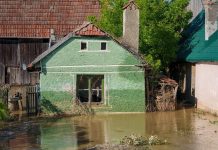In the future, Sidex Slag Dump, with an area of 110 ha and heights of up to 50 meters, will look like a landscape from Mars, with arid land, 100% composed of oxides of calcium, potassium, manganese and phosphorus pentoxide, but without any trace of vegetation.
The closure of the dump, a colossus of 54 million tons of slag, sparked much controversy and a DNA case. It is a polluting landfill, whose dust, carried by the wind, has reduced the fertility of the fields in the area and, therefore, must be closed and greened. It is on the list of the 68 non-compliant landfills for which Romania has been convicted by the Court of Justice of the European Union for failing to fulfill its obligation to join, to close these landfills in accordance with Directive 1999/31 / EC. The project presented in the recent years involved covering the dump with a layer of earth, for vegetation to grow on it.
Now, the dump is to be closed, the part of the project related to the ground cover has been removed, because 3.6 million euros would be an investment too expensive. In the new variant, of 2.25 million euros, the dump will be abandoned, so that the rainwater and snow will ”self-cement” the slag mountain, transforming it into a ”sarcophagus”, similar to Chernobyl.
The DNA prosecutors are also interested in closing the dump
The closure and greening of the dump has already led to a criminal case. On January 4, the National Anticorruption Directorate (DNA) announced the start of criminal proceedings against former Environment Minister Costel Alexe for receiving bribe from one of the plant’s directors to help the company ”monitor the measures taken by this factory to close a warehouse of non-compliant waste (slag dump). That deposit is one of the 68 unclosed deposits for which the Romanian state was convicted by the Court of Justice of the European Union, in 2018, for not fulfilling the obligation assumed as an EU member state to close them as soon as possible”, said DNA, in a press-release.
A colossus of 54 million tons of slag, with an area of 110 hectares and heights of up to 50 meters
The slag dump is a new form of relief that appeared near Galați after the construction of the plant, in the 60s. Currently, it consists of 54 million tons of steel and blast furnace slag, resulting from the technological processes at the plant. It covers 110 hectares and has a maximum height of 50 meters. In 2009, the storage at the dump was stopped, the slag resulting from the technological processes being taken to the ecological landfill from ”Valea Lupului”.
But the Slag Dump is still exploited for the extraction of iron ”rugs” used as raw materials. A quantity of 5 million tons of slag is processed annually, from which the quantity of 740,000 tons of iron is extracted. In the recent years, the amount of iron extracted has decreased. ”Removing metal is no longer as it was 5-6 years ago, but the quantities still help us in our operation,” said Ionel Dumitru, head of the plant’s Internal Logistics Department.
The slag hut should have been closed in 2014, but the owner of the plant at the time, businessman Lakshmi Mittal, obtained from the Ponta Government the authorization no. 1/2015, by which the operation was extended until 2023. In 2019, the ArcelorMittal trust sold the plant in Galați to the “Liberty Steel” trust, which is part of the GFG Alliance Group, controlled by businessman Sanjeev Gupta. Last year, the former Sidex, under the new name, the “Liberty” Steel Plant, asked the Environmental Protection Agency (APM) Galati for the necessary approvals to close the slag hut.
Chemical composition of the slag hut: 26,000 tons of quicklime, plus oxides of potassium, magnesium, phosphorus, aluminum, iron, manganese
According to the data from the Environmental Impact Report regarding the closure of the hut, the slag consists of 12 chemical compounds. The most important of these is ”calcium oxide” (CaO), which represents 49.06% of the mass of slag. Other important compounds are ”iron oxide III” (Fe2 O3), which represents 21.5% of the slag mass, ”silicon dioxide” (Si O2), 8% content, ”alumina” (Al2 O3) with a content of 2.96%, ”magnesium oxide” (MgO), with a content of 2.83%, ”manganese oxide” – 1.94%, ”phosphorus pentoxide” (P2 O5) – 1.63%. With contents below 1% are ”sodium oxide” (Na2O), ”potassium oxide” (K2O), ”chromium oxide III” (Cr2 O3) and ”titanium dioxide” (Ti O2).
Almost half of the slag is represented by ”calcium oxide”, which in the specialty literature is presented as follows: ”Calcium oxide (quicklime, burnt lime) has the form of a white powder, which reacts vigorously with water, effervescent with the release of heat forming calcium hydroxide (slaked lime) ”. Therefore, out of the total quantity of 54,000,000 tons of slag, approximately 26,460,000 tons is ”quicklime”.
Since there have been no accidents caused by the chemical composition of the slag in the fifty years since the hut exists, there is probably no imminent risk, but in terms of the long-term storage effects of this tailings colossus, which generates dust in an inhabited area, health experts should rule.
A public debate with announced result: ISPE specialists claim that the only appropriate method is to ”self-cement” the dump
The costs of closing the Slag Hut are paid by ”Liberty” Plant. On March 11, APM Galați organized, at the ”Liberty Club” in Galați, the public debate of the Environmental Impact Report of the Project ”Closure of non-hazardous waste landfill Slag Hut within Liberty Galaţi SA and Stabilization of the shore of the river Mălina”. The 247-page report was made by by the Institute of Energy Studies and Design (ISPE) Bucharest, at the request of ”Liberty” Plant. Following the debate, the agency’s specialists had some observations and ”Liberty” Plant submitted the revised Report no. 68 / 19.04.2021, also prepared by ISPE.
In both versions of the report, ISPE specialists presented four ”reasonable alternatives”:
“Alternative 1” – Closure according to Order 757 of November 26, 2004 for the approval of the Technical Norm on waste storage issued by the Ministry of Environment and Water Management;
”Alternative 2” – Closure by self-cementing the surface layer of slag;
”Alternative 3” – Closure with a layer of earth;
”Alternative 4” – Closure by using a polymer / resin solution for coating. ISPE specialists should have been limited to presenting technical solutions, with costs and advantages and disadvantages in terms of environmental impact, without commenting in support of a particular method, leaving environmental protection experts the right to decide an alternative.
However, in the written report, but also in the public debate, ISPE representatives strongly opposed the rejection of alternatives 1-3-4, which they considered inappropriate, supporting the application of ”Alternative 2 – self-cementing”, which involves only a leveling of steep areas and abandoning the slag mountain so that, under the action of rains, a crust forms on the surface of the hut.
”I discovered the self-strengthening process by visiting the construction site in the Slag Hut area and finding that, where no more work was done for two months, it practically got a crust, it became a pseudo-cement. So, practically, no more drifting. I reproduced this phenomenon in the laboratory and I found that in about two months it is enough to wet the slag with water, to have this self-cementing. This is the reason why we promoted the solution”, said during the public debate Sebastian Săcuiu, the head of the Environmental Engineering Department within ISPE.
We have a first observation here. The slag hut was under the action of rain and snow in the 60’s, but it did not ”self-cement” too much and, after 1990, there were dozens of lawsuits by farmers in the area who sued the Steel Plant, because the slag dust decreased the productivity of agricultural lands.
Risk elimination strategy: ”If we encounter a dry period, these surfaces will be watered with tanks!”
After 2009, when the storage was stopped, there was a lot of talk about covering the dump with a layer of earth, so that the sterile dust would not pollute the lands in the area, the “miraculous” solution suddenly appeared: do nothing! It will be expected that the rains will determine the formation of the crust on the surface of the dump, and, if there will not be enough precipitation, water will be brought with tanks.
”If the precipitations are weak and we hit a dry period, these surfaces will be watered with tanks, sprinklers, so that, in a first phase, the process of scattering is prevented and, in a second phase, we achieve the self-reinforcement we expect”, said the head of the Environmental Engineering Department at ISPE.
After all, it’s all about the money: covering the slag hut with earth costs 3.6 million euros, and ”self-cementing” costs only 2.25 million euros!
When we think about the issue of greening an area that has been ecologically destroyed as a result of an industrial activity, we first of all think about the desired result after greening, the elimination of waste and the restoration of the initial aspect of the area, with vegetation. But the specialists from ISPE Bucharest did not take into account this priority, based only on the calculation of the amounts that will be spent for greening the ”client” of ISPE – ”Liberty” Steel Plant.
”From a technical and economic point of view, it turned out that Alternative 2 (self-cementing) is the most feasible”, said in the public debate Oana Falup, engineer in the Thermo mechanical Section of ISPE.
Here are the costs of the four methods: ”Alternative 1”, the closure of the dump according to order 757/2004 of the Ministry of Environment and Water Management, costs 39.53 million euros. This method is applicable in the case of closing an old landfill, where it is necessary to build gas and leachate networks and an 85 cm layer of soil for stabilization, a layer of waterproofing and a layer of 15 cm of fertile soil. ”Alternative 2” – ”self-cementing”, costs 2.25 million euros, the money being spent mainly for the creation, in steep areas, of slopes in the ratio 1/3, to stabilize the slopes. ”Alternative 3”, cover with a 15 cm layer of fertile soil, would cost 3.6 million euros, the costs being generated by land transport. ”Alternative 4” – with polymers, involves spraying the hut with a solution of polymer / resin to form an impermeable crust and would cost 5.45 million euros.
The ISPE specialists recommended the cheapest method, ”self-cementing”, of 2.25 million euros, although covering with a 15 cm layer of earth would have been 1.35 million euros more expensive, but would have ensured the greening of the 110 ha.
The big surprise! The Ministry of Environment is also supporting ”the client”, because it approved the closure of the Slag Hut by ”self-cementing”
„The Investigation Newspaper” also addressed the Ministry of Environment, requesting a point of view on the technical solution for closing and greening the Slag Hut in Galați, which through the 110 hectares of land is the largest of the 68 warehouses for which Romania has been convicted by the Court of Justice of the European Union. The Ministry of Environment informed us that has taken the decision to issue the environmental agreement for the closure of the Slag Dump by ”self-cementing”. The decision is based on the argument of ISPE specialists, that rainwater strengthens the slag!
”Following the analysis from the point of view of environmental protection of the proposed alternatives, the best technical solution for closing the non-hazardous waste landfill from Liberty Galați SA is the one that consists in the self-cementing process of the surface slag layer. The solution chosen for closing the slag dump was selected after evaluating 4 analyzed alternatives. Alternatives 1 and 3 are the ones you are referring to. During the procedure for issuing the environmental agreement, all 4 closure alternatives were evaluated, and Alternative 2 was chosen as optimal”, it is said in the address of the Communication Department within the Ministry of Environment.
The response of the Ministry of Environment also states a ridiculous argument: ”the coverage with a layer of earth of 15 cm determines changes in the stability of the hut, by supplementing the weight borne by the foundation ground and the body of the hut.” That means that the 15 cm layer of soil, respectively a volume of 150,000 m3, evenly distributed on 110 ha, would lead to the collapse of the 54,000,000 m3 of slag?!
Decision ”forced” by twisted calculations, like in the jokes about Erevan Radio
In support of ”self-cementing” and discouraging land cover, ISPE experts also used calculations, but calculated how much land would be needed for Alternative 1, which applies to the closure of landfills, for which two layers of soil are used (100 cm), not for Alternative 3, useful for closing a slag heap and which involves covering with a layer of 15 cm. It’s like the jokes about Radio Yerevan: it wasn’t ”Alternative 1”, but ”Alternative 3”, it wasn’t household waste, it was slag!
”The question is where to get a million cubic meters of topsoil, which you can weed. One million cubic meters means, to some extent, two million tons of land. And, if we divide two million tons into a 20-ton dump truck, it means 200,000 dump trucks”, said Sebastian Săcuiu, during the public debate.
As mentioned before, it is a biased calculation. According to the report, Galați Slag Hur would need a volume of 950,000 cubic meters only in the case of closure according to ”Alternative 1”, which applies to the closure of landfills and which requires an additional layer of earth (85 cm) to alleviate settlement caused by the decomposition of waste, to which is added the layer of 15 cm, covered with fertile soil. At a slag hut, which is stable, you can apply ”Alternative 3”, covering it with a layer of earth of 15 cm. At the hut in Galați, a volume of 150,000 m3 of land would be needed.
According to Normative act no. 10/2003, approved by Order 1.215 / 10.01.2003, regarding the specific density of materials in warehouses, one cubic meter of soil is equivalent to a quantity of 400 kg, if it is dry soil and 700 kg, if it is wet soil. We will take into account the equivalence of one cubic meter of land
that ”equals” 700 kg. The volume of 150,000 cubic meters of land is equivalent to 105,000 tons and, to transport it, it would require 5,250 trips with dump trucks of 20 tons. So, it’s not about 200,000, but 5,000 races with 20-ton dump trucks.
„Where do you get so much land?” Galați City Hall has a reserve of 360 ha of land, at a few hundred meters from the fence of the Complex
One reason for rejecting the greening option of covering the dump with fertile soil is that it would be difficult to find the required amount of soil. ”Where do you get topsoil, which you can grass,” said the ISPE representative, Sebastian Săcuiu, during the public debate. This concern of the ISPE representatives ”infected” those from the Ministry of Environment also, and, in their response to ”The Investigation Newspaper”, referred to ”major difficulties in procuring the land needed to cover such a large area.”
We have an effective solution to this problem. Galati City Hall has, in the northwest of the city, near the steel platform, just a few hundred meters from the fence of the ”Liberty” Complex, an area of 360 hectares for the future development of Galati, both in terms of urban and economic view. Part of that land is sloping, and an area of 60 hectares on which were the orchard and the vineyard of a former company, is even terraced. As the construction of residential neighborhoods or industrial halls would require a prior leveling of the land at ”zero level”, it would be useful for some of the surplus land to be excavated and used to cover the Slag Hut with earth. For the volume of 150,000 cubic meters of land, an area of 33 ha should be uncovered by 0.5 meters. The problem can be solved by leveling the terraced land.
We contacted the mayor of Galați, Ionuț Pucheanu, who told us that he did not know about this situation, but it would not be a problem to help the Steel Works to solve the problem: “If they ask us, we will do everything we can to help”, said the mayor Ionuț Pucheanu.
As there are only a few hundred meters between the respective lands and the steel platform, the transport costs would be minimal, because the means of transport would travel a few hundred meters to the North Gate of the complex, cross the steel platform and reach the Slag Hut, which is in the southern part of the complex. Therefore, covering the dump with a 15 cm layer of fertile soil is an “impossible mission” only in the imagination of the specialists from ISPE Bucharest, who were not even interested in finding opportunities.
The vulnerable point: the criminal phenomenon. ”Self-cementing” cannot stop the assault of iron thieves on the hut
Over the years, a criminal phenomenon has appeared in the Slag Hut area: iron thieves scouring the slag to find the pieces of iron to take to the iron collection centers, which have proliferated in the area of the slag.
”If the dump is not closed and secured, it is as if it will never be closed again! Who will guard an area of 110 hectares, on which you can find slag with pieces of iron? If it is not secured, the Slag Hut will continue to be exploited, especially at night. In Galați, but also in the localities around the hut, in Movileni, Șendreni, there are hundreds of people who live from the recovered iron, who deal with this”, said the president of the SME Board of Trustees from Galați, Marian Filimon.
There was a time when the police raided the hut every day, to remove iron thieves. The criminal phenomenon no longer has the same magnitude, but it is proved by the fact that, near the hut, there are 7-8 iron collection centers. Violent conflicts often occur between iron thieves. On March 18, 2021, at a collection center, there was a settlement of accounts between two iron thieves, and a 32-year-old man was stabbed by ”the competition” and ended up in the hospital.
If the Slag Hut is abandoned in anticipation of ”self-cementing”, it is almost certain that the iron thieves will uncover it, searching for pieces of iron and the criminal phenomenon will increase even more.
Will the European Commission accept the ”self-cementing” of the Slag Hut with rainwater?
It is said that, after ”self-cementing”, a park of photovoltaic panels will appear in the place of the Slag Hut, but there is no project, no feasibility study, no funding sources, and the company of businessman Sanjeev Gupta is facing financial problems. In this context, the only certainty is the sentence by which Romania was convicted by the Court of Justice of the European Union for not closing 68 landfills, including the Slag from Sidex.
It remains to be seen how the European Commission will react to the news that the 110 hectares of tailings from the Slag Hut in Galați have been ”greened” by ”self-cementing” it with rainwater.







